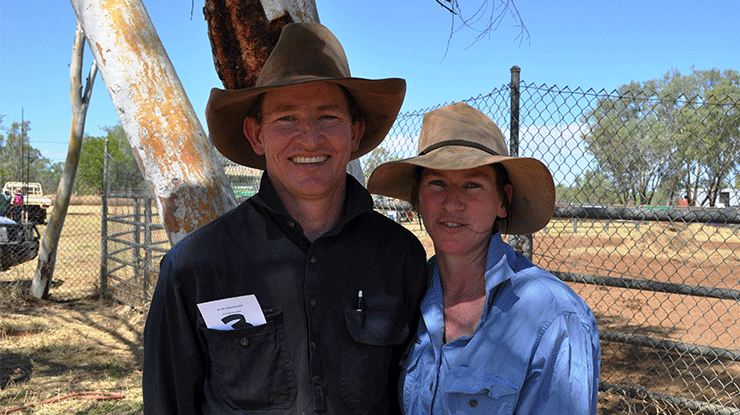An eye for detail underpins profitability
12 May 2021
 Anne Marie Huey and her partner Mike De Long run Dampier Downs Station, WA.
Anne Marie Huey and her partner Mike De Long run Dampier Downs Station, WA.
Operating an extensive beef enterprise in the remote west Kimberley region of WA is not without its challenges, but Anne Marie Huey and her partner Mike De Long are making incremental changes to improve their bottom line.
Anne Marie and Mike run ‘Dampier Downs Station’, a 265,000ha cattle property geared to the live export market.
Anne Marie credits participating in MLA’s Business EDGE course with helping her to improve her business skills to drive the profitability of the business.
Business EDGE is a two‑day financial and business management training workshop for producers who want to improve the efficiency and profitability of their business.
“Mike and I are really focused on the cattle side of our business and I also have a strong background in natural resource management, but we needed to strengthen our business management skills,” Anne Marie said.
“By attending MLA’s course we were able to better focus on the profit drivers of our station and make changes to maximise our bottom line.”
Transport costs
The first thing Anne Marie did after attending the Business EDGE course in Broome was to reorganise their financial statements to drill down and work out where the money was going in and out.
“Through this process I realised that a few days spent realigning a small section of our main trucking road would enable us to send an extra trailer of sale cattle out at a time.
“While this had always been on the to‑do list, the business analysis highlighted how a small outlay now will save time and money in the future.”
Objective decisions
Anne Marie also came away with an understanding of the importance of calculating the real operating costs of their business.
“I realised I needed to allocate myself and Mike a wage in order to work out the true profitability of the business,” she said.
“This is something we’ve never done but will focus on going forward so we can have an objective view of the business and make informed decisions rather than going on gut feelings.”
New opportunities
As Anne Marie started to focus on the business side of their beef enterprise, she saw the opportunity to develop an off‑farm income.
“I spent days sorting our financial statements, the reports from our bookkeeping program and the templates we’d received from the course into a format that made sense to our business.
“I thought to myself, I’m sure there are a lot of businesses that either don’t have the time or skills to do this.
“So, I’m in the process of launching my own business to help small to medium‑sized livestock enterprises that need admin and office support but don’t have enough scale to justify a full‑time employee.”
|
Lessons learned
|
|
Four drivers of a profitable northern beef business Here are four areas Anne Marie Huey and Mike De Long focus on to drive the profitability of their WA beef enterprise to achieve their production goals, which include:
1. Managing breeders “Tightening our calving window to make sure calves are born during the wet season is a priority,” Anne Marie said. “This is obviously a challenge as we continuously‑mate and our extensive enterprise doesn’t lend itself to controlled mating. “Instead, we pregnancy test our breeders and segregate according to calving windows. The earlier in the season we can do this, the more options we have for our out‑of‑season calvers. “We’re also planning on implementing a targeted heifer management plan – we hope to control mate the heifers, setting them up to have their first calf around the break of season. “This will give them the best opportunity to remain in sync with the seasons and allow us to identify sub‑fertile females.” 2. Breeding better cattle Although their main market is live export, Anne Marie and Mike send cull cows and other out‑of‑spec animals to a local abattoir. Using this as a marketing option has allowed them to selectively spay lower quality females, to drive genetic improvement in their herd. They use estimated breeding values to select all bulls, and target key characteristics such as fertility and growth traits. 3. Reducing mortality Spaying aged cows not only improves overall herd genetics but also lowers mortality rates. “Reducing mortality is a key profit driver for our business,” Anne Marie said. “Phosphorus supplementation also plays a critical role in reducing mortality – we’re severely phosphorus deficient and addressing this is arguably the best investment we make on a yearly basis.” 4. Managing for the environment Wet seasons are variable, but limited marketing options means Anne Marie and Mike can’t significantly vary herd numbers based on seasonal conditions. “If we do have an above‑average year, we don’t have enough mouths to eat the grass and are presented with a larger fire risk the following dry season,” Anne Marie said. “It’s important to have a well‑managed fire regime so I am always keeping an eye on the Bureau of Meteorology to monitor conditions. “With our approach to management we’re constantly monitoring our pastures to ensure we’re moving stock to another area if a paddock starts to look overgrazed. “Therefore, we move the cattle based on the condition of the pasture rather than looking at the condition of the cattle to prevent them from losing weight.” |


